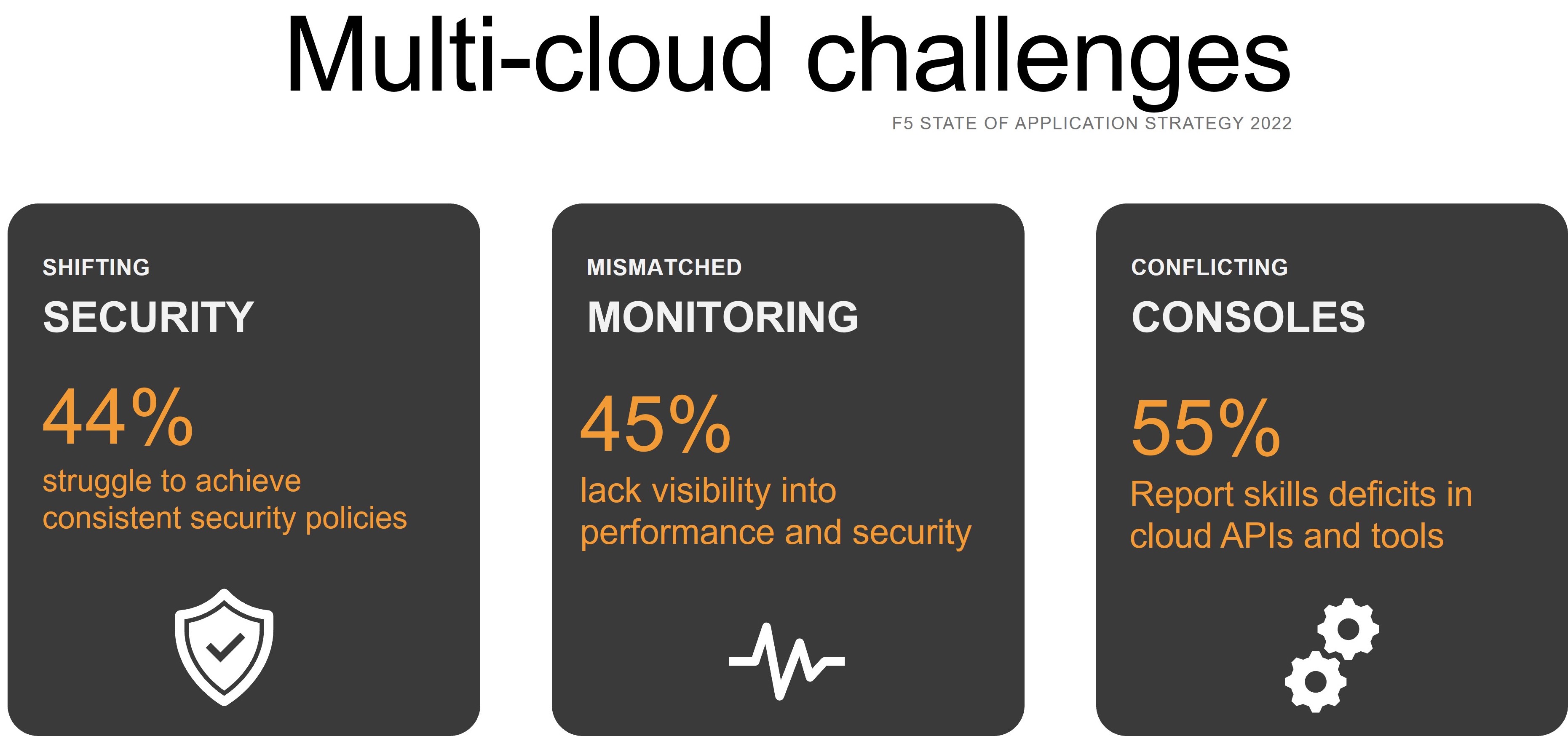Estratégia de Aplicação do Estado 2022: A complexidade da multi-nuvem continua
Inevitavelmente, todas as empresas serão multi-nuvem e forçadas a enfrentar a complexidade que isso traz às operações, à segurança e à força de trabalho.
Não será surpresa para ninguém saber que diversas organizações que responderam à nossa pesquisa anual State of Application Strategy nos disseram que têm aplicativos em diversas nuvens. Mais de três quartos — 77% para ser exato — são atualmente multi-nuvem no sentido tradicional.
Digo sentido tradicional porque minha declaração inicial leva em consideração que uma preponderância de organizações também está usando uma ou mais ofertas de nuvem como serviço. E por preponderância, quero dizer quase todos, com impressionantes 93%. Na verdade, as organizações consomem em média 2,9 ofertas diferentes de "como serviço". Para aqueles que imediatamente descartam a adoção generalizada observando que toda empresa usa algum tipo de SaaS, deixe-me dizer que a versão 2.9 inclui o que é cada vez mais agrupado como XaaS, com:
- 36% consumindo Segurança como Serviço, como WAF baseado em nuvem, DDoS ou gerenciamento de bots
- 35% consomem infraestrutura como serviço, geralmente denominada “nuvem pública”
- 25% usando Processo de Negócios como Serviço
- 21% usando Containers-as-a-Service
- 31% aproveitando a plataforma como serviço
Gostaria de destacar ainda que a adoção da computação de ponta além das CDNs tradicionais e da distribuição de serviços de segurança também está aumentando. Uma porcentagem significativa de organizações planeja implantar cargas de trabalho de aplicativos e dados na borda, indicando que a computação de borda está bem encaminhada para se tornar uma plataforma de aplicativos.
Isso estende os desafios da multinuvem para a borda, principalmente porque muitas das mesmas tecnologias e ferramentas que as organizações usam para desenvolver, implantar e operar aplicativos em várias nuvens estão sendo estendidas para a borda.
E, claro, não podemos esquecer que muitas organizações operam nuvens privadas no local.
Então, para resumir, multi-cloud é a fusão de núcleo, nuvem e borda, e é definida principalmente por seu modelo operacional comum. Ou seja, o uso de APIs para interagir, definir, implantar e operar recursos.
O problema é que todas essas APIs são únicas. Não da maneira como são acessadas, porque as APIs hoje são principalmente chamadas REST baseadas em HTTP com protocolos e formatos de dados bem compreendidos (principalmente JSON). Mas os modelos reais com os quais essas chamadas de API pretendem interagir e os processos necessários para provisionar, gerenciar e até mesmo monitorar corretamente os recursos baseados em nuvem são todos muito diferentes e exclusivos do provedor.
É por isso que o XaaS é tão importante: porque ele introduz mais uma API em um conjunto já superlotado de APIs de nuvem. Porque nenhuma organização “simplesmente consome” XaaS. Há conexões de volta à organização — seja para acesso ou como parte de um fluxo de trabalho — que são possíveis pelas APIs.
É aí que a complexidade bagunça as coisas e introduz desafios que continuam a atormentar as empresas hoje. Desafios que permaneceram praticamente os mesmos desde que começamos a perguntar sobre eles; ou seja: segurança consistente, visibilidade e migração de aplicativos entre propriedades de nuvem.
Embora esses três desafios tenham mudado de posição entre os desafios multinuvem ao longo dos anos, todos os três sempre estiveram entre os cinco primeiros.
A novidade deste ano é o aumento impressionante no déficit de habilidades auto-relatadas associadas a APIs e ferramentas de nuvem. No ano passado, essa lacuna de habilidades foi relatada por um terço — 33% — dos entrevistados. Este ano? Aumentou drasticamente para mais da metade, para 55%. Embora não seja diretamente um “desafio multi-nuvem”, esse aumento o torna merecedor de um lugar na minha lista dos três principais desafios multi-nuvem em 2022.

Mas nem tudo é frustrante em um mundo multinuvem. Por exemplo, aqueles que nos disseram que operam aplicativos em várias nuvens têm muito mais probabilidade de ter as ferramentas necessárias para relatar a integridade dos aplicativos. Ou seja, quase 2,5x mais provável. Isso pode ocorrer devido à ênfase inerente na instrumentação nativa em aplicativos nativos da nuvem, que, sem surpresa, têm mais probabilidade de serem implantados em um ambiente de nuvem pública. O uso de uma malha de serviços, por exemplo, geralmente é parcialmente motivado pela necessidade de visibilidade em ambientes em cluster, o que fornece as métricas necessárias para relatar a integridade de aplicativos baseados em contêineres. A maior parte dos aplicativos tradicionais são monólitos cada vez mais antigos que permanecem no local, muitos dos quais nunca foram projetados para suportar a instrumentação necessária para monitorar adequadamente seu status e integridade. Abordagens de monitoramento baseadas em agentes são caras para manter e operar — sem mencionar a escala — e, portanto, são mais propensas a serem encontradas monitorando aplicativos considerados essenciais para a experiência do cliente. O viés na seleção de dados é um desafio significativo que impede as organizações de obter visibilidade total e, sem dúvida, continua a prejudicar os esforços para monitorar aplicativos tradicionais que podem ser vistos como não essenciais.
A complexidade não pode ser apagada. As organizações vão operar de forma multi-nuvem e, à medida que se estendem para a borda, isso só fará com que a complexidade cresça. Mas isso pode ser gerenciado, e essa é a tarefa que os líderes de tecnologia devem abraçar e que os fornecedores estão buscando resolver.
Há mais insights sobre multi-nuvem e edge em nosso relatório anual. Recomendo que você o adquira hoje mesmo e dê uma lida.
Confira blogs relacionados para se aprofundar em tópicos selecionados:
Estratégia de Aplicação do Estado 2022: Desembalando 8 anos de tendências ›
Estratégia de Aplicação do Estado 2022: A segurança muda para a identidade ›
Estratégia de Aplicação do Estado 2022: Inovadores digitais destacam a importância da modernização ›
Estratégia de Aplicação do Estado 2022: Tendências de desempenho ›
Estratégia de Aplicação do Estado 2022: Hora de modernizar as operações ›
Estratégia de Aplicação do Estado 2022: O futuro dos negócios é adaptável ›
